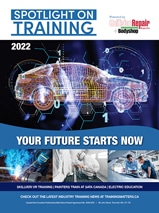MEET GRETA CUTULENCO, THE 28-YEAR-OLD CEO USING AI TO CHANGE THE INDUSTRY
Acerta Analytical Solutions is taking a different approach to artificial intelligence.
The Kitchener-based company uses AI to create testing algorithms from manufacturer-collected data to scan and pinpoint any software glitches in parts–before they roll off the assembly line. The process strives to combat warranty claims, recalls, and reduced profit while boosting product quality.
With a goal of eliminating scrap and rework early in the assembly line, cut costs in the supply chain and improve overall vehicle quality, Acerta aims to lead the evolution of machine intelligence in Canada. Bodyworx Professional spoke to Greta Cutulenco, Acerta’s 28-year-old CEO and co-founder, to ask her about the company’s use of AI and how it is affecting the auto repair industry.
Bodyworx Professional: How does Acerta use AI technology compared to the rest of the industry and why?
Greta Cutulenco: Acerta is leveraging AI to help automakers get their products to market faster and with fewer defects. We do this by using machine learning to detect the earliest indicators of future product failures based on production, on-road and end-of-line (EOL) testing data. Many companies have been trying to extract value from all the manufacturing data they are collecting with AI, but Acerta is unique, as we focus on the automotive industry. We have an extensive history of working with datasets from transmissions, axles, gearboxes, engines, and other automotive systems, that gives our machine learning models an edge in automotive applications compared with generic AI solutions. And our models are getting better every day: we’re constantly updating and optimizing our model performance.
BW: What makes Acerta’s technology such a game-changer in your estimation?
GC: Nowadays, cars are basically big computers on wheels, and whether you’re driving them or making them, they generate a lot of data. All of the added complexity means there are more ways than ever for a vehicle or assembly to fail, but the volume of data involved makes identifying root causes difficult and time-consuming. I see Acerta supporting the entire automotive product lifecycle, using AI to find insights in that huge volume of production and on-road data. Our models can help engineers and technicians predict when a vehicle or assembly will fail and, more importantly, why. On the factory floor, that means better end-of-line testing and higher production efficiencies. On the road, it means fewer breakdowns and better vehicle servicing.
BW: What should collision repair facilities be doing to make themselves ready for AI?
GC: The first thing everyone needs to do to “get ready” for AI is learn: educate yourself about what artificial intelligence is and what it isn’t, what it can and can’t do. There’s so much hype around the concept of AI that it’s starting to feel like an empty buzzword, but there’s a difference between companies who actually understand AI and use it and those that just want to have the keyword on their website. Learn the difference so you know who to trust. More specifically for collision repair facilities, start with a use case. Find a problem that can’t be solved in the traditional way and then see if AI can help you solve it either quicker, cheaper, or in a more scalable way. If you start the other way around and try to apply it to everything, you’re going to be disappointed.
BW: What impact will this have on their business?
GC: The proliferation of mechatronic systems in vehicles has made diagnostics, servicing and repairs more complex than ever before, but collision repair facilities can meet that challenge by augmenting their technicians’ knowledge and skills with AI and machine learning. Most technicians can’t diagnose modern vehicle failures without computational assistance, even if that’s something as basic as diagnostic trouble codes (DTCs) collected via the onboard diagnostics (ODB) port. AI can catch failures that might not be flagged by DTCs, but even when a technician has identified the problem, the complexity of modern vehicle systems means that outright replacement is often preferable to repair, despite the potentially higher costs in parts and labour. With AI, technicians can use vehicle data not only to detect and diagnose more failures but also generate recommendations for repairs



























